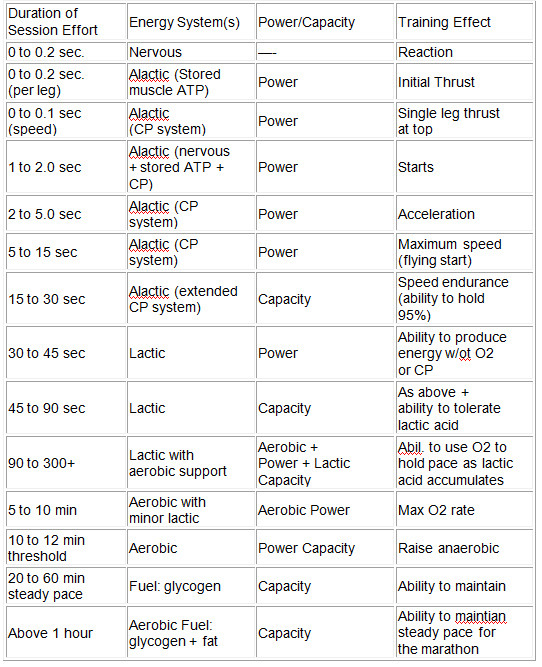|
Sprint Training – Energy Systems
Start off first by knowing just a little about the physical patterning of your sprinter. Do you know what your sprinter's stride length is? Do you know what your sprinter's stride frequency is? If not, then you're playing a game (and some of you very successfully) of sprinter's roulette. Don't have your sprinters running fast in spite of your training; it should be in conjunction with as much of your training and speed development as possible. Aerobic training has nothing to do with sprinting, and should never be used to make your sprinter faster. Aerobic training is good for the development of the cardiovascular system to enable you to recover from the tough workouts and helps in the development of running more reps and learning to run rounds. But there is nothing about a 1000 breakdown, or 5-10 miles of running that will enable your sprinter to improve from 12.5 to 12.2. You need to know what the body is affected by when you sprint, and you need to train those areas and perfect them so that when it's time to "punch" it, they "punch it" like a Top Fuel Funny Car and not like the neighborhood garbage truck. But that is what you are doing when you go outside of the energy system requirements preset in the sprint. The following chart outlines the duration of effort, the energy system it touches, the use of either power or capacity, and the training effect. If you are doing starts, it is clear that you're working in the 0.0 to 5.0 second range. So what? Well, you need to know a little about the biochemistry of the body which states: The legs have stored ATP (look it up) in them and lasts for 2 muscle contractions. During that moment 0.0-.20 equals reaction to the stimulus of the gun Each one of these areas has an energy system that you can tie into which lets you know what distances you should be covering because you have the duration that the system is available to you. If you are a 200 meter girl, and wish to train your speed endurance, you must touch on the 15 30 second range which allows you to run very fast, at a very high percentage of your maximum effort. Do not train speed endurance at less than 90% or you will lock in a slower muscular recruitment and thereby get a slower muscular response. Want to run fast? Train fast. "But she's got to get strong," you say. If your girls run 10 x 200 at 75% with short recovery, they'll be 3 x 3 x 60 meters on the fly Alactic Power Try not to run more than 150 to 175 seconds worth of actual running on the track. It works out to a lot of running very fast if you go up that high. 1000-800-600-400 Lactic with Aerobic Support*** ***Be careful here because you have to ask yourself, what is it about a 400 in 49 or 54 seconds that has anything to do with needing aerobic support. But this system does let you know what areas to train your 800-1600-3200 kid when it comes to what system will make you a more capable runner. Finally, train for speed first and you will be able to run at a reduced percentage of that speed for a longer distance. But if you start slow and try to run fast off the slower velocity, you will more often than not find yourself on the raw end of someone's kick. TRAINING ENERGY SYSTEMS |




 strong as sin. But when they run against my girls, who have run 1 x 250 in 30 sec. with 20 mins. and 1 x 180 in 21.6, I win. That's because my girls can endure at the target pace of the run, while yours can run a whole bunch of them, but slower than sin! Of course this is not all I do all year, and you may think that 10 x 200 is necessary in the beginning; it has its place, but not to make her fast. If it is an aerobic workout, call it that, but do not call it speed. If my boy is a 50 flat boy, and I run 3 x 500 fast with good recovery, then I'm working the lactic capacity (the ability to tolerate lactic acid which deadens the muscle's ability to maintain the power needed to go fast).
strong as sin. But when they run against my girls, who have run 1 x 250 in 30 sec. with 20 mins. and 1 x 180 in 21.6, I win. That's because my girls can endure at the target pace of the run, while yours can run a whole bunch of them, but slower than sin! Of course this is not all I do all year, and you may think that 10 x 200 is necessary in the beginning; it has its place, but not to make her fast. If it is an aerobic workout, call it that, but do not call it speed. If my boy is a 50 flat boy, and I run 3 x 500 fast with good recovery, then I'm working the lactic capacity (the ability to tolerate lactic acid which deadens the muscle's ability to maintain the power needed to go fast).
